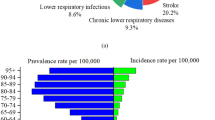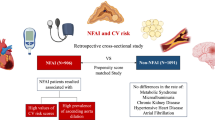Abstract
In this contribution we test the hypothesis that nonlinear additive autoregressive model-based data analysis improves the diagnostic ability based on short-term heart rate variability. For this purpose, a nonlinear regression approach, namely, the maximal correlation method is applied to the data of 37 patients with dilated cardiomyopathy as well as of 37 age- and sex-matched healthy subjects. We find that this approach is a powerful tool in discriminating both groups and promising for further model-based analyses.






Similar content being viewed by others
References
Aguirre LA, Billings SA (1995) Improved structure selection based on term clustering. Int J Control 62:569–587
Aguirre LA, Correa MV, Cassini CCS (2002) Nonlinearities in narx polynomial models: representation and estimation. IEE Proc Part D Control Theory Appl 149:343–348
Baselli G, Cerutti S, Badilini F, Biancardi L, Porta A, Pagani M, Lombardi F, Rimoldi O, Furlan R, Malliani A (1994) Model for the assessment of heart period and arterial pressure variability interactions and of respiration influences. Med Biol Eng Comput 32:143–152
Berntson GG, Bigger JT, Ckberg DL, Grossman P, Kaufmann PG, Malik M, Nagaraja HN, Porges SW, S.J.P, P. H. Stone, an der Molen MW (1997) Heart rate variability: origins, methods, and interpretative caveats. Psychophysiology 34:623–648
Billings SA, Leontaritis IJ (1982) Parametric estimation techniques for nonlinear systems. In: Proceedings of 6th IFAC symposium ident., parameter estimation, Washington, pp 427–432
Breiman L, Friedman J (1985) Estimating optimal transformations for multiple regression and correlation. J Am Stat Assoc 80:580–619
Censi F, Calcagnini G, Lino S, Seydnejad SR, Kitney RI, Cerutti S (2000) Transient phase locking patterns among respiration, heart rate and blood pressure during cardiorespiratory synchronisation in humans. Med Biol Eng Comput 38:416–426
Cerutti S, Carrault G, Cluitmans PJ, Kinie A, Lipping T, Nikolaidis N, Pitas I, Signorini MG (1996) Non-linear algorithms for processing biological signals. Comput Methods Programs Biomed 51:51–73
Chen R, Tsay R (1993) Nonlinear additive arx models. J Am Stat Assoc 88:955–967
Chon KH, Kanters JK, Cohen RJ, Holstein-Rathlou NH (1997) Detection of chaotic determinism in time series from randomly forced maps. Phys D 99:471–486
Focus issue: dynamical disease: mathematical analysis of human illness. Chaos 5:1–344
Focus issue: mapping and control of complex cardiac arrhythmias (2002) Chaos 12:732–981
Goldberger AL, Rigney DR, Mietus J, Antman EM, Greenwald S (1988) Nonlinear dynamics in sudden cardiac death syndrome: heartrate oscillations and bifurcations. Experientia 44:983–987
Gray RA, Pertsov AM, Jalife J (1998) Spatial and temporal organization during cardiac fibrillation. Nature 392:75–78
Haber R, Keviczky L (1976) Identification of nonlinear dynamic systems. In: IFAC symp. ident. syst. parameter estimation, Tbilisi, Georgia, pp 62112
Hastie T, Tibshirani R (1990) Generalized additive models. Chapman and Hall, London and New York
Heart rate variability standards of measurement, physiological interpretation and clinical use (1996) Task force of the european society of cardiology and the north american society of pacing and electrophysiology. Circulation 93:1043–1065
Holm S (1979) A simple sequentially rejective multiple test procedure. Scand J Stat 6:65–70
Ivanov PC, Amaral LA, Goldberger AL, Havlin S, Rosenblum MG, Struzik ZR, Stanley HE (1999) Multifractality in human heartbeat dynamics. Nature 399:461–465
Kantz H, Kurths J, Mayer-Kress GE (1998) Nonlinear analysis of physiological data. Springer, Berlin Heidelberg New York
Kleiger RE, Miller JP, Bigger J, Moss A (1987) Decreased heart rate variability and its association with increased mortality after acute myocardial infarction. Am J Cardiol 59:256–262
Kurths J, Voss A, Witt A, Saparin P, Kleiner H, Wessel N (1995) Quantitative analysis of heart rate variability. Chaos 5:88–94
La Rovere MT, Pinna GD, Maestri R, Mortara A, Capomolla S, Febo O, Ferrari R, Franchini M, Gnemmi M, Opasich C, Riccardi P, Traversi E, Corbelli F (2003) Short-term heart variability predicts sudden cardiac death in chronic heart failure patients. Circulation 107:565–570
Lakatta EG, Levy D (2003) Arterial and cardiac aging: major shareholders in cardiovascular disease enterprises: Part ii: the aging heart in health: links to heart disease. Circulation 107:346–354
Lombardi F (2002) Clinical implications of present physiological understanding of hrv components. Card Electrophysiol Rev 6:245–249
Lu S, Chon KH (2003) Nonlinear autoregressive and nonlinear autoregressive moving average model parameter estimation by minimizing hypersurface distance. IEEE Trans Sig Proc 51:3020–3026
Malik M, Padmanabhan V, Olson WH (1999) Automatic measurement of long-term heart rate variability by implanted single-chamber devices. Med Biol Eng Comput 37:585–594
Poon CS, Merrill CK (1997) Decrease of cardiac chaos in congestive heart failure. Nature 389:492–495
Renyi A (1970) Probability theory. Akadémiai Kiadó, Budapest
Rompelman O, Coenen AJ, Kitney RI (1977) Measurement of heart-rate variability: Part 1—comparative study of heart-rate variability analysis methods. Med Biol Eng Comput 15:233–239
Schmidt G, Malik M, Barthel P, Schneider R, Ulm K, Rolnitzky L, Camm AJ, Bigger JTJ, Schomig A (1999) Heart-rate turbulence after ventricular premature beats as a predictor of mortality after acute myocardial infarction. Lancet 353:1390–1396
Special issue virtual tissue engineering of the heart (2003) Int J Bifurcat Chaos 13:3531–3804
Szabo BM, van Veldhuisen DJ, van der Veer N, Brouwer J, De Graeff PA, Crijns HJ (1997) Prognostic value of heart rate variability in chronic congestive heart failure secondary to idiopathic or ischemic dilated cardiomyopathy. Am J Cardiol 79:978–980
Tsuji H, Larson MG, Venditti FJ, Manders ES, Evans JC, Feldman CL, Levy D (1996) Impact on reduced heart rate variability on risk for cardiac events. Circulation 94:2850–2855
Voss H, Kurths J (1997) Reconstruction of non-linear time delay models from data by the use of optimal transformations. Phys Lett A 234(5):336–344
Voss A, Kurths J, Kleiner HJ, Witt A, Wessel N, Saparin P, Osterziel KJ, Schurath R, Dietz R (1996) The application of methods of non linear dynamics for the improved and predictive recognition of patients threatened by sudden cardiac death. Cardiovasc Res 31:419–433
Voss HU, Kolodner P, Abel M, Kurths J (1999) Amplitude equations from spatiotemporal binary-fluid convection data. Phys Rev Lett 83(17):3422–3425
Wessel N, Voss A, Kurths J, Schirdewan A, Hnatkova K, Malik M (2000) Evaluation of renormalised entropy for risk stratification using heart rate variability data. Med Biol Eng Comput 38:680–685
Wessel N, Voss A, Malberg H, Ziehmann C, Voss HU, Schirdewan A, Meyerfeldt U, Kurths J (2000) Nonlinear analysis of complex phenomena in cardiological data. Herzschr Elektrophys 11:159–173
Wessel N, Ziehmann C, Kurths J, Meyerfeldt U, Schirdewan A, Voss A (2000) Short-term forecasting of life-threatening cardiac arrhythmias based on symbolic dynamics and finite-time growth rates. Phys Rev E 61:733–739
Wessel N, Schirdewan A, Kurths J (2003) Intermittently decreased beat-to-beat variability in congestive heart failure. Phys Rev Lett 91:119801
Wessel N, Malberg H, Walther T (2004) Heart rate turbulence higher predictive value than other risk stratifiers? Circulation 109:e150–e151
Wessel N, Aßmus J, Weidermann F, Konvicka J, Nestmann S, Neugebauer R, Schwarz U, Kurths J (2004) Modeling thermal displacements in modular tool systems. Int J Bifurcat Chaos 14:2125–2132
Wessel N, Konvicka J, Weidermann F, Nestmann S, Neugebauer R, Schwarz U, Wessel A, Kurths J (2004) Predicting thermal displacements in modular tool systems. Chaos 14:23–29
Wikswo JPJ, Lin SF, Abbasm RA (1995) Virtual electrodes in cardiac tissue: A common mechanism for anodal and cathodal stimulation. Biophys J 69:2195–2210
Witkowski FX, Leon LJ, Penkoske PA, Giles WR, Spano ML, Ditto WL, Winfree AT (1998) Spatiotemporal evolution of ventricular fibrillation. Nature 392:78–82
Yamamoto Y, Hughson RL (1994) On the fractal nature of heart rate variability in humans: effects of data length and beta-adrenergic blockade. Am J Physiol 266:R40–R49
Yang AC, Hseu SS, Yien HW, Goldberger AL, Peng CK (2003) Linguistic analysis of the human heartbeat using frequency and rank order statistics. Phys Rev Lett 90:108103
Zipes DP, Wellens HJ (1998) Sudden cardiac death. Circulation 98:2334–2351
Acknowledgments
We would like to thank Henning Voss for providing the Matlab-code and very helpful discussions as well as the Deutsche Forschungsgemeinshaft (DFG BA 1581/4-1, BR 1303/8-1, KU 837/20-1) for supporting the study.
Author information
Authors and Affiliations
Corresponding author
Appendix: the ACE algorithm
Appendix: the ACE algorithm
This appendix provides a short description of the ACE algorithm of Breiman and Friedman [6], the computer programs used can be obtained from the authors (http://tocsy.agnld.uni-potsdam.de/). In the following section, the same notations as introduced in Sect. II are used.
Generally, the estimation of functions that are optimal for correlation is equivalent to the estimation of functions that are optimal for regression. Therefore, the problem
may also be expressed as the regression problem
Here, the functions θ and ϕ j (j=1,...,k) are varied in the space of Borel measurable functions, and the constraints onto these functions are that they have vanishing expectation and finite variances to exclude trivial solutions.
For the one-dimensional case (k=1), the ACE algorithm works as follows: When denoting the conditional expectation of ϕ1 (T 1) with respect to S by E[ϕ1 (T 1)|S], then the function \(\bar{\phi}_{0} (S) = E[\phi_{1} (T_{1})|S]\) minimizes (9) with respect to θ(S) for a given ϕ1(T 1). Similarly, \(\bar{\phi}_{1} (T_{1}) = E[\theta(S)|T_{1}]/||E[\theta(S)|T_1]||,\) where the norm is defined by \(||Z||=\sqrt{\hbox{var} [Z]},\) minimizes (9) with respect to ϕ1 (T 1) for a given θ (S), keeping E[ϕ 21 (T 1)]=1. Now, the ACE algorithm consists of the following iterative procedure: Starting with the initial function
from i=2 it is calculated recursively
and
until E[(ϕ (i)1 (T 1) − θ(i)(S))2] fails to decrease. The limit values are then estimates for the optimal transformations θ and ϕ1. For the minimization of the right hand side of Eq. 9 a double-loop algorithm is used. In the additional inner loop, the functions
are calculated. In the sum, the superscript “.(i)” is used for p < j and “.(i-1)” for p > j. For k > 1, the ACE algorithm works similarly.
There are several possibilities of estimating conditional expectations from finite data-sets. In our examples, local smoothing of the data is used. This smoothing can be achieved with different kernel estimators. We use a simple boxcar window, i.e. the conditional expectation value E[y|x] is estimated at each site i via
for a fixed half window size N. In all examples of this paper, n=30 is used to account for a reliable estimate of the mean value.
Furthermore, to allow for a better estimation in the case of inhomogeneous distributions, the data are transformed to have rank-ordered distributions prior to the application of the ACE algorithm [i.e. the data-set X is sorted in ascending order, resulting in the vector Y and all further calculations are performed with the corresponding index vector I, where Y=X(I)]. This allows for a more precise estimation of expectation values independently of the form of the data distribution and simplifies the algorithm considerably. It is allowed, since the rank transformation is invertible and the maximal correlation is invariant under invertible transformations by definition. Proofs of convergence and consistency of the function estimates are given in Ref. [6].
Rights and permissions
About this article
Cite this article
Wessel, N., Malberg, H., Bauernschmitt, R. et al. Nonlinear additive autoregressive model-based analysis of short-term heart rate variability. Med Bio Eng Comput 44, 321–330 (2006). https://doi.org/10.1007/s11517-006-0038-0
Received:
Accepted:
Published:
Issue Date:
DOI: https://doi.org/10.1007/s11517-006-0038-0




